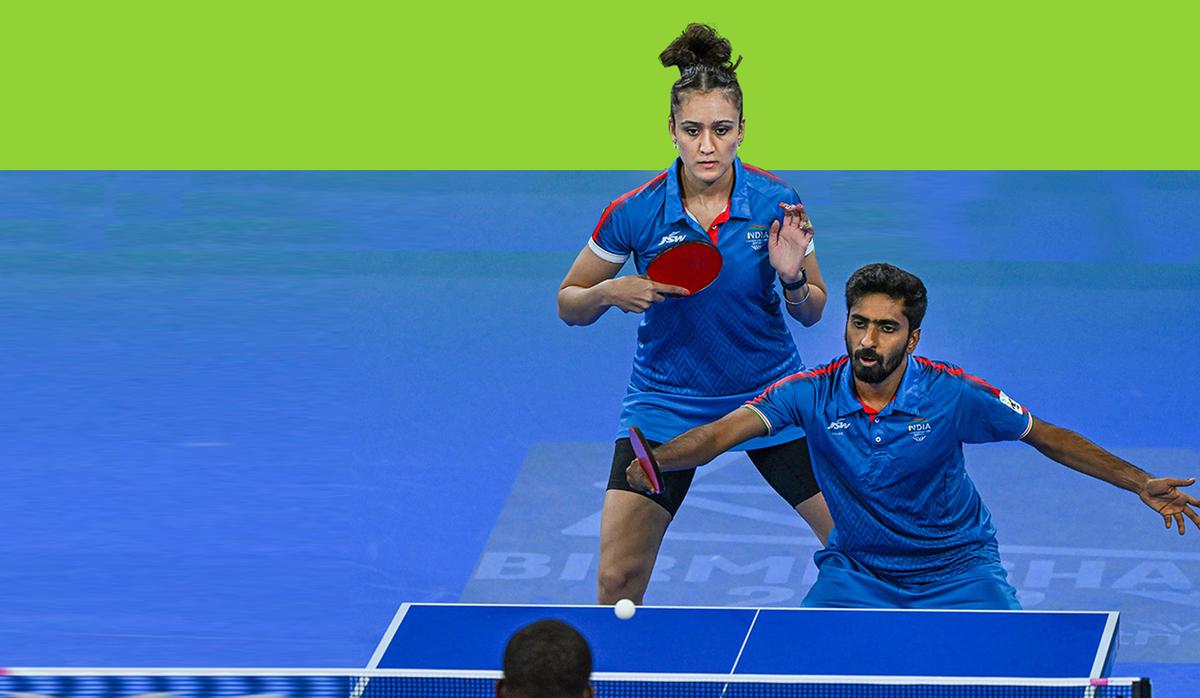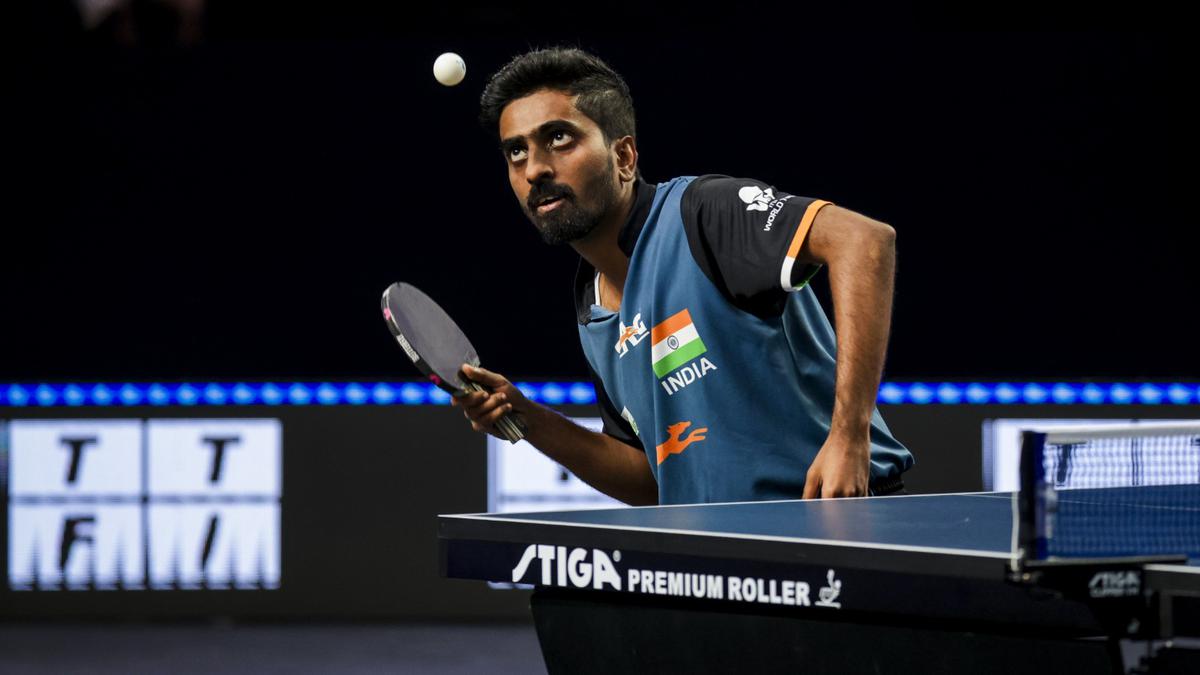Sathiyan singles form tumbles as focus shifts to mixed doubles for Olympic bid
Down two match points in his men’s singles qualifying round match at the WTT Star Contender in Goa, India’s Sathiyan Gnanasekaran needed a couple of solid serves to keep him in the contest.
His resultant effort only sat up at a convenient height for France’s Vincent Picard to unleash a forehand cross-court winner past the Indian’s outstretched paddle. Just like that, Sathiyan’s tournament was over. Having made it to the Round of 16 at the same tournament a year ago, the 31-year-old failed to even make the main draw in 2024, losing 7-11 11-7 6-11 11-7 8-11 to Picard.
The result caps a troubling trend for someone who, until very recently, was undoubtedly India’s top men’s singles player. In January 2018, Sathiyan broke into the top 40 of the world rankings for the first time in his career. He spent four years in that elite grouping, peaking in 2019 at 24th—the highest ever rank held by an Indian men’s singles player.
In recent months, though, his ranking has fallen precipitously. Sathiyan was world number 94 at the time of his qualifying round match. His loss against Picard (WR 194), ranked a hundred places below him, will only see his ranking slide further. At the domestic stage, Sathiyan failed to defend his national crown, losing to India’s current top-ranked player, Harmeet Desai, in the 2023 finals.
Some of the blame for Sathiyan’s form can be put on inopportune injuries. He suffered a knee injury at the WTT Contender in Antalya just shortly after the Asian Games last year, recovered, and then pulled a muscle in his lower back. “It’s come at a critical period,” Sathiyan would say.
ALSO READ | WTT Star Contender: With Feeder title under her belt, Sreeja Akula sets course for Paris 2024
“I got an MRI done. Luckily, it’s not a tear but a stress injury. I need to take a break, but if you do, you will miss the Olympics directly. I don’t have three weeks. I had to pull out of the finals of the Vijaywada ranking series because of the pain. I also played the nationals while taking pain medication. I’m not fully injured, and I’m not fully fit. My physio said that given a chance, you should definitely take a break, get better, and come back. But then the qualification period ends when I take a break. There is no choice but you push harder. It has been a bit hard,” he says.
But Sathiyan can’t stop pushing hard. While his singles campaign is over, Sathiyan isn’t yet done with the tournament. His best chances lie in the mixed doubles event. He remains part of the highest-ranked India pair in the tournament; his partnership with Manika Batra is currently ranked world number 10.
While Sathiyan’s singles performance has slipped in the last year, in mixed doubles alongside Manika Batra, he has reached the quarterfinal stage of the Singapore Smash, the WTT Star Contender in Goa and Bangkok, and the semifinals of the WTT contender in Tunis.
It’s not just in Goa where Sathiyan will look at the mixed doubles. As the Paris Olympics loom closer, Sathiyan is aware that his strongest hopes of qualifying for his second Games lie in the mixed doubles event, the qualification event for which is in April this year. And even if he doesn’t qualify from that tournament, he and Manika should still likely qualify via ranking.
Focus on doubles
As a result, Sathiyan has been prioritising his doubles partnership with Batra, even at the expense of his singles prospects.
“After the national championships, I’ve managed to play without pain, but still, I feel I was not going with a 100 percent strength. And that affects you mentally but somehow with the mixed doubles in focus – the mixed doubles is really important. I need to give 100 percent there,” he says.

FILE: Sathiyan remains part of the highest-ranked India pair in the tournament; his partnership with Manika Batra is currently ranked world number 10.
| Photo Credit:
PTI
FILE: Sathiyan remains part of the highest-ranked India pair in the tournament; his partnership with Manika Batra is currently ranked world number 10.
| Photo Credit:
PTI
I’ve made the decision to focus on the mixed doubles. I missed a lot of singles feeder events (which would allow him to boost his ranking points against relatively weaker opponents) because they were clashing with the mixed doubles events where we needed to do well. At the same time, playing the contender and star contender tournaments was important from the perspective of mixed doubles. I had to take a call,” he adds.
Sathiyan says he decided to do so after realistically weighing his chances as a singles player at the Olympics.
“Certainly, it felt bad (to see his rankings dip) You do want to have good world ranking and I was in the top 30 and 40s for 3-4 years. But to be honest, even at that ranking it is very unlikely that I’d get a medal in the singles event at the Olympics. I’ve participated once before where I made it to the second round. I think if I had a good tournament I might be able to go another two rounds but even that would be two rounds away from the medals. In the mixed doubles you start out as 16 pairs and in two rounds you could make the semifinals. Once you are there, anything can happen. It’s a fair chance and an Olympic medal is an Olympic medal,” he says.
Physical overload
But a focus on mixed doubles carries its own challenges. For one, it’s a lot harder on the body than purely playing singles. “In table tennis you don’t have separate players for doubles. There aren’t a lot of specialists still. It’s hard on the body. You play one hour of singles then you are tired and then you have one hours break and then you are planning for mixed doubles. It’s too much. Mixed doubles is a lot more tiring than singles. In singles if you hit the ball, you are just waiting for the opponent to play his shot. But in mixed doubles, you have to play and then move to give your partner the space. You have to keep moving in sync and hope that you don’t get tangled. If Manika goes to the right, then I need to step back. Once Manika and I started putting in the work in mixed doubles, that’s when we realised how tiring it is. And that’s when you start facing all these issues with your lower back,” he says.
That’s what happened to him. “Its very demanding on your body to play both events with the same intensity. I have to accept I am not as physically strong as a top athlete. So I have to improve but it takes time to get better. If you just push – and I did that – then I could see the body is saying ‘relax’. If I go that way then I am done. I did that for six months. If I went ahead with even more events, then I could have picked up an injury,” he says.
READ MORE | Kamlesh Mehta: Hoping for optimal participation and improved results in Table Tennis at Paris Olympics 2024
But even while Sathiyan is willing to focus on mixed doubles, there’s another catch. Even though his singles ranking has slipped, his partner Manika Batra remains India’s highest-ranked women’s singles. For Manika, singles remain as much a priority as mixed doubles.
This means that two paddlers, who train in separate centres (Sathiyan out of Chennai and Manika out of Hyderabad), rarely get to train together. “I think over the last year we might have trained together for only about 15 days in all because our commitments keep varying. We’ll have a maximum of 4 or 5 day camp together. Even if Manika is not there, I play a few doubles in training just to try and get that movement going,” he says. While a common base would be ideal, Sathiyan is uncertain how that would work. “Unfortunately, we don’t have a national centre. That is one thing we need to have where we can have camps and everything,” he says.
The next best thing, he says, would be to train together at competitions where they are competing. But even that doesn’t happen as much as it should. “Usually we don’t want to train at a tournament because we want to be in the match zone. But that’s something we need to do. We are at a tournament for a week, and we might only be playing a couple of times. That’s what the Chinese, Japanese, and top Asians do. We need to figure out something that works because we have back-to-back events. We’ve been on tour for almost 4 weeks now, so where else would you train?” he says.
Eventual specialisation
With the workload as hectic as it is, Sathiyan can’t stop playing doubles entirely, even though he believes the future of table tennis will lie in specialisation. “Historically, there’s been less importance given to doubles in the past. This Olympics will be the first time mixed doubles is a separate medal event at the Olympics. But at this stage I can’t advise someone to focus completely just on doubles. At the Asian Games or Commonwealth Games you have to focus on singles because according to the rules it’s your singles performance on the basis of which you qualify for the team and you have to be in the team to play both singles or doubles. The system doesn’t support specialisation. But I think in the end it will be inevitable that we will have doubles specialists like you have in badminton,” he says.
For the moment, though, Sathiyan will try to manage both events at least until the Olympic qualifying period ends in the first week of May. “I’ll continue to play as many tournaments as possible to keep our mixed doubles rankings up. Till the Olympics qualifications we need to play everything but once that is over we need to pick and choose events. The Korean pair (top seeded duo of Shin Yubin and Lim Jonghoon) have played nearly every tournament in the past 2 years. They are a top pair and they too feel the need to do this. The focus for me is the mixed doubles and hopefully we will try to qualify in that period. After that I’ll try and get fully fit. I’m not very worried about my singles ranking. I know it’s just the matter of getting a couple of good tournaments and I’ll be back in the top 50 once again,” he says.



